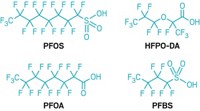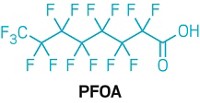Advertisement
Grab your lab coat. Let's get started
Welcome!
Welcome!
Create an account below to get 6 C&EN articles per month, receive newsletters and more - all free.
It seems this is your first time logging in online. Please enter the following information to continue.
As an ACS member you automatically get access to this site. All we need is few more details to create your reading experience.
Not you? Sign in with a different account.
Not you? Sign in with a different account.
ERROR 1
ERROR 1
ERROR 2
ERROR 2
ERROR 2
ERROR 2
ERROR 2
Password and Confirm password must match.
If you have an ACS member number, please enter it here so we can link this account to your membership. (optional)
ERROR 2
ACS values your privacy. By submitting your information, you are gaining access to C&EN and subscribing to our weekly newsletter. We use the information you provide to make your reading experience better, and we will never sell your data to third party members.
Persistent Pollutants
US drinking water to be tested for 29 PFAS
EPA will use data to determine public health risks
by Cheryl Hogue
December 22, 2021
US utilities will have to monitor the drinking water they supply for the presence of 29 per- and polyfluoroalkyl substances (PFAS) from 2023 through 2025, under a regulation the US Environmental Protection Agency issued Dec. 20.
The EPA will use the monitoring data to determine whether these environmentally persistent synthetic compounds need regulation in drinking water to protect public health.

“We are advancing the science and the monitoring that are necessary to protect all communities from PFAS,” EPA Administrator Michael S. Regan says in a statement.

All 29 PFAS selected for monitoring contain reactive sites. The chemicals include sulfonic acids and carboxylic acids of perfluoroalkyls and fluorethers.

Two of the chemicals, perfluorooctanoic acid (PFOA) and perfluorooctanesulfonic acid (PFOS), are widespread water contaminants even though they are no longer manufactured in the US. Exposure to PFOA or to PFOS is associated with cancer, immune system dysfunction, and endocrine disruption. The EPA plans to propose legally enforceable limits on these chemicals in drinking water in 2022.

Two other chemicals on the monitoring list are related to substances developed by chemical companies to replace PFOA as manufacturing aids to produce fluoropolymers. One is 4,8-dioxa-3H-perfluorononanoic acid, the parent acid of 3M’s ADONA ammonium salt. The other is hexafluoropropylene oxide dimer acid (HFPO-DA), the chemical that forms when Chemours’s GenX hydrolyzes into in the presence of water.
Two chemicals that are environmental transformation products of certain commercial PFAS, including the pesticide sulfluramid, are also on the list. The compounds, which include N-ethyl perfluorooctane sulfonamido acetic acid (N-EtFOSAA), eventually break down into PFOS.
In addition, the EPA selected two chlorinated polyfluorinated ether sulfonic acids for monitoring in drinking water. The two are components of a mixture known by the trade name F-53B that was developed in China and is used as a replacement for PFOS in the electroplating industry.
Along with the 29 PFAS, the EPA is requiring utilities to monitor for the presence of lithium in drinking water. The element, which occurs naturally in some groundwater, is found at levels that could pose a risk to human health in 45% of US public-supply water wells, according to a study released in February.
CORRECTION:
This article was updated on Dec. 29, 2021, to correct the name 4,8-dioxa-3H-perfluorononanoic acid. The original omitted the 4. The N-EtFOSAA structure label was also amended on Dec. 23, 2021, to add the second A.





Join the conversation
Contact the reporter
Submit a Letter to the Editor for publication
Engage with us on Twitter